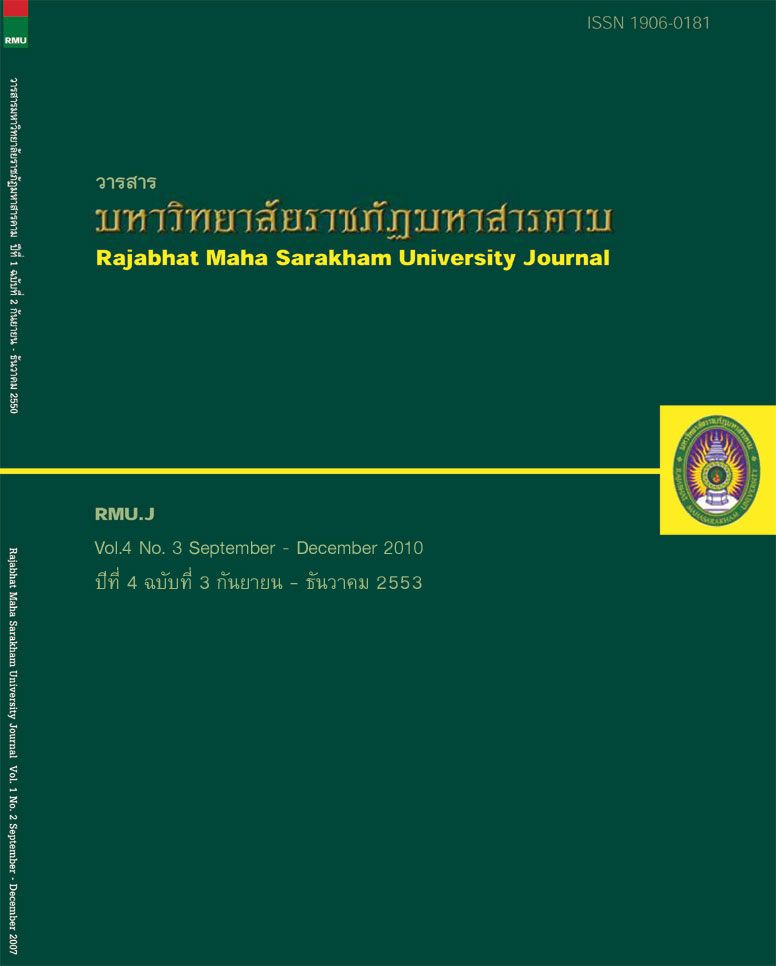รูปแบบการสอนอ่านภาษาอังกฤษเพื่อความเข้าใจโดยการใช้ยุทธศาสตร์การเสริมต่อการเรียนรู้ ประสบการณ์การอ่านสำหรับนักศึกษามหาวิทยาลัยราชภัฏ Development of an English Reading Comprehension Instructional Model Through Scaffolding Reading Experience Strategies
Main Article Content
บทคัดย่อ
การวิจัยครั้งนี้มีวัตถุประสงค์เพื่อพัฒนารูปแบบการสอนอ่านภาษาอังกฤษเพื่อความเข้าใจโดยการใช้ยุทธศาสตร์การเสริมต่อการเรียนรู้ประสบการณ์การอ่าน และศึกษาประสิทธิภาพของรูปแบบการสอนนี้สำหรับนักศึกษามหาวิทยาลัยราชภัฏโดยใช้การวิจัย 3 ระยะคือ (1) การศึกษาบริบทเพื่อกำหนดกรอบแนวคิดและสร้างต้นร่างรูปแบบการสอนใช้การวิจัยเชิงสำรวจและการศึกษาเอกสารกลุ่มเป้าหมายเป็นนักศึกษาระดับปริญญาตรี หลักสูตรสาขาวิชาภาษาอังกฤษ มหาวิทยาลัยราชภัฏมหาสารคาม จำนวน 100 คน และอาจารย์ที่มีประสบการณ์การสอนอ่านภาษาอังกฤษ จำนวน 3 ท่าน เก็บรวบรวมข้อมูลโดยใช้แบบสอบถามความคิดเห็นเกี่ยวกับปัญหาและอุปสรรคในการอ่านภาษาอังกฤษเพื่อความเข้าใจและแบบสัมภาษณ์กึ่งโครงสร้าง วิเคราะห์ข้อมูล โดยการหาค่าร้อยละ และการวิเคราะห์เนื้อหา (2) การพัฒนาประสิทธิภาพของรูปแบบการสอนใช้การวิจัยเชิงปฏิบัติการ ด้วยแผนการสอน
6 แผนๆ ละ 3 ชั่วโมงรวม 18 ชั่วโมง กลุ่มเป้าหมายเป็นนักศึกษาระดับปริญญาตรี หลักสูตรสาขาวิชาภาษาอังกฤษที่เรียนรายวิชากลวิธีการอ่านอนุเฉท ภาคเรียนที่ 2 ปีการศึกษา 2551 จำนวน 30 คน โดยการเลือกแบบเจาะจง เก็บรวบรวมข้อมูลโดยการใช้แบบบันทึกการเรียนรู้ แบบสังเกตพฤติกรรมการเรียนการสอน และแบบทดสอบวัดความสามารถในการอ่านภาษาอังกฤษเพื่อความเข้าใจ วิเคราะห์ข้อมูลโดยการหาค่าร้อยละ ค่าเฉลี่ย ส่วนเบี่ยงเบนมาตรฐาน และการวิเคราะห์เนื้อหาเพื่อเปรียบเทียบความสามารถในการอ่านก่อนและหลังการทดลองโดยการทดสอบที (3) การยืนยันประสิทธิผลของรูปแบบการสอนใช้การวิจัยกึ่งทดลอง กลุ่มเป้าหมายเป็นนักศึกษาระดับปริญญาตรี หลักสูตรสาขาวิชาภาษาอังกฤษที่เรียนรายวิชากลวิธีการอ่านอนุเฉท ภาคเรียนที่ 1
ปีการศึกษา 2552 จำนวน 60 คน แบ่งเป็น 2 กลุ่ม คือ กลุ่มที่ได้รับการสอนโดยการใช้ยุทธศาสตร์การเสริมต่อการเรียนรู้ประสบการณ์การอ่าน กับการสอนตามปกติ เก็บรวบรวมข้อมูลโดยการใช้แบบทดสอบวัดความสามารถในการอ่านภาษาอังกฤษ
เพื่อความเข้าใจ วิเคราะห์ข้อมูลโดยการเปรียบเทียบความสามารถในการอ่านระหว่างกลุ่มทั้งก่อนและหลังการสอนโดยการทดสอบที่ผลการวิจัยพบว่า
ตัวผู้เรียน บทอ่าน และจุดประสงค์ในการอ่านและการนำไปใช้ ที่มีกิจกรรมการสอน 3 ขั้นตอนคือ 1. ขั้นก่อนการอ่านมีกิจกรรมย่อย คือ 1) การสร้างแรงจูงใจและการกำหนดจุดประสงค์ในการอ่าน 2) การกระตุ้นความรู้เดิมและสร้างความรู้พื้นฐานในการอ่าน 3) การแนะนำยุทธวิธีในการอ่าน 2. ขั้นการอ่าน มีกิจกรรมย่อย คือ 1) การอ่านให้ผู้เรียนฟัง 2) การอ่านในใจ 3) การอ่านตามคำแนะนำ และ 3. ขั้นหลังการอ่าน มีกิจกรรมย่อย คือ 1) การตั้งคำถามหลังการอ่าน 2) การสรุปและทำแผนภูมิความคิด 3) การประยุกต์ใช้ 4) การประเมินผลการเรียนรู้ และรูปแบบการสอนมีประสิทธิภาพผ่านเกณฑ์ที่กำหนด นักศึกษาที่ได้รับการสอนด้วยรูปแบบการสอนนี้มีความสามารถในการอ่านภาษาอังกฤษเพื่อความเข้าใจสูงกว่ากลุ่มที่ได้รับการสอนตามปกติอย่างมีนัยสำคัญทางสถิติที่ระดับ .01
This research aimed to construct an instructional model to improve students' English reading comprehension skills through scaffolding reading experience strategies and to assess the efficiency of the English reading comprehension instructional model. The research methodology was comprised of three phases: contextual study, development of an instructional model and implementation of the model. Phase 1: the contextual study was done in order to build an instructional framework of the reading comprehension instructional model for university students by using survey technique and review of related literature and research. The target group consisted of three experienced English reading instructors and one hundred undergraduate students majoring in English at Rajabhat Maha-Sarakham University. The data were collected by using a semi-structured interview form and a questionnaire on problems and difficulties in English reading comprehension. The data were analyzed by using percentage and content analysis. Phase 2: the English reading comprehension instructional model was designed and developed by the action research with six 3-hour-lessonplans. The target group was thirty undergraduate students of the English Curriculum Program at Rajabhat Maha Sarakham University who studied "Paragraph Reading Strategies" in 2/2008. The sample subjects were selected by purposive random sampling. The data were collected by using a learning behavior observation form, an instructional observation form and an English reading comprehension test. The research statistics used were percentage, mean, standard deviation and t-test. The data were analyzed by descriptive statistics and content analysis, and used to compare the reading proficiency of students before and after the experiment. Phase 3: the quasi-experimental research was done in order to assess the efficiency of the instructional model. The target group was sixty English majored undergraduate students who studied "Paragraph Reading Strategies" in 1/2009. The students were divided into two groups. Group1 studied who studied "Paragraph Reading Strategies" course with scaffolding reading experience strategies, and group 2 had a regular class of "Paragraph Reading Strategies" course. The data were collected by a reading comprehension proficiency test and t-test was used to compare the reading proficiency of the students before and after the experiment using t-test. The findings revealed that the English reading comprehension model with scaffolding reading experience strategies for Rajabhat Maha-Sarakham University students consisted of two phases: 1) contextual study and planning, and 2) implementation. The implementation consisted of three main phases. 1. Pre-reading activities consisted of setting learning objectives and warm up activities, activating background knowledge and improving reading skills, introducing reading strategies. 2. While-reading activities consisted of reading to students, silent reading and guided reading. 3. Post-reading activities consisted of 1) writing questions after reading 2) summarizing and writing conceptual diagram 3) applying the knowledge and 4) assessment. The research finding indicated that the efficiency of this instructional model regarding the standardize criteria was qualified. The average score of reading comprehension proficiency of the students who studied through the scaffolding reading experience strategies was significantly higher than that of the control group at the .05 level.
Article Details
1. บทความที่ลงตีพิมพ์ทุกเรื่องได้รับการตรวจทางวิชาการโดยผู้ประเมินอิสระ ผู้ทรงคุณวุฒิ (Peer Review) สาขาที่เกี่ยวข้อง อย่างน้อย 3 ท่าน ในรูปแบบ Double blind review
2. ข้อคิดเห็นใด ๆ ของบทความที่ลงตีพิมพ์ในวารสารมหาวิทยาลัยราชภัฏมหาสารคาม นี้เป็นของผู้เขียน คณะผู้จัดทำวารสารไม่จำเป็นต้องเห็นด้วย
3. กองบรรณาธิการวารสารมหาวิทยาลัยราชภัฏมหาสารคาม ไม่สงวนสิทธิ์การคัดลอกแต่ให้อ้างอิงแสดงที่มา

